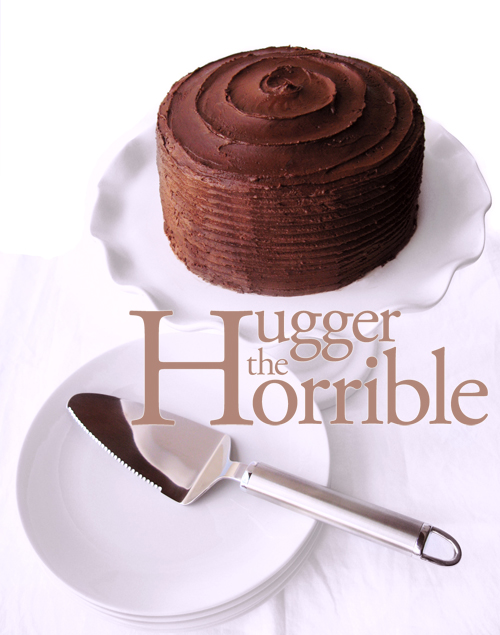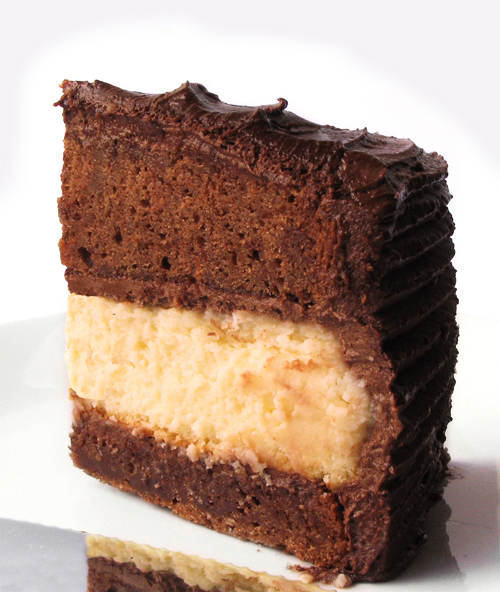Devil's Food Cheesecake

I think it's a fair observation to say that hugging is most prevalent in American society. The (beloved and sadly breathing its last) show Pushing Daisies once described them as "emotional heimlichs" wherein "someone puts their arms around you and they give you a squeeze and all your fear and anxiety come shooting out of your mouth in a big wet wad and you can breath again." In recent years I've sensed a backlash against what might be considered excessive invasion of private space among Americans. I don't mind if it goes either way, I'm pretty flexible (and I certainly don't want to be caught in the middle of this debate-- settle it among yourselves!). I've been trying to understand how the emotional heimlich-- a gesture of welcoming and caring-- suddenly got such a bad reputation. I don't touch people on an emotional level very often but I have to admit, when it counts, it does feel good. Maybe the backlash is against devaluing the hug, or giving it away when there is no emotion behind it.
Warning: truly neurotic thinking coming up. Last October I met up with the awesome Todd and Diane. Because I was in total nerd-mode, my brain went through several hundred if:then iterations of how I should go about greeting them. When I saw Diane coming up from the curb, with her terrawatt smile, there was little doubt in my mind that a hug was the only way to go. Todd was coming up a few meters behind, though. Now, I doubt you will find many more guys more welcoming and just darn-nice than Todd, but not wanting to look like a space-invading fool, I shook his hand instead. Brain: WARNING: DIVISION BY ZERO. Trust me, this is not uncommon interaction between men. After all, we have complex algorithms for determining which urinal we stand in front of at the restroom. To be fair, Todd and Diane are not the kind of people to persecute me for any social faux pas, so: sorry, and thank you.
Now, though I'm in the potions and leeches business these days, I still consider myself a closet mathematician. What I have here is a poll. And before you (Jen) roll your eyes and say, "Good grief!" This is not a way to fish or to paint myself in a puppy-dog light. I really want to know the correct probability of doing the correct thing in (and I cannot stress this enough) a hypothetical meeting between me and another food blogger. Pretend we have had a reasonable amount of interaction via e-mail and through the blogs. As I said, I really don't care if all of you answer "No"-- I said I could go either way on the issue of hugging. But I do care about looking either too standoffish and cold, or invasive and inappropriate. Besides, this could be fun. You don't have to reveal or explain your answer, but if you feel like doing so, it should be an interesting read. I've stratified the poll into male/female (the answerer), in case there might be a difference.
Hugging?
What does hugging have to do with devil's food cheesecake? Absolutely no-thing, huh! But I saw this recipe from the ill-conceived Throwdown with Bobby Flay and I haven't been able to put it out of my head: it's from Junior's Cheesecakes, which I understand isn't even universally embraced. (Huh, see what I did there?) It works, for the most part. The cheesecake is as perfect as I've ever made a classic cheesecake-- not a crack in sight, the top lightly golden, perfectly smooth, rounded at the rim. The devil's food cake leaves a bit to be desired. Sure, I scaled it down, but the problem is just it's not chocolatey/bitter/dark enough. By the way, proper devil's food cake is made with buttermilk. It is better the next day, though. The icing is also a bit too sugary, but it does go well with the cake and cheesecake.
Devil's Food Cheesecake adapted from The Junior's Cheesecake Cookbook
This recipe is scaled down to fit a 6-inch pan. If you're eating cheesecake sandwiched between chocolate cake and butter frosting, that probably sounds like the right size to do it in anyway.
Cheesecake layer
For this recipe, you may use a 6-inch cake pan, springform pan, or cake ring. If using a springform or ring, wrap the outside with plenty of aluminum foil, covering the bottom and seam especially, extending to the top edge. If using a cake pan, line the bottom with parchment and have on hand a piece of clean stiff circular cardboard 6 inches in diameter. In any case, spray the inside with baking spray. Preheat the oven to 175°C (350°F).
In a medium mixing bowl, place the cream cheese, sugar, cornstarch, and vanilla, and beat until creamy and well-combined, scraping down the sides of the bowl occasionally. Blend in the egg until just incorporated. Beat in the cream just until it's completely blended-- no more. Pour the batter into the prepared pan and place it in a shallow pan containing hot water that comes about 1 inch up the outside of the pan with the cheesecake. Bake until the edges are light golden brown and the top is slightly golden tan, about 1 hour. It will still jiggle in the middle when you shake it, but don't overdo the jiggling or you will crack it for sure. Cool in the water bath until the water is just warm and transfer to a wire rack. Cool in the pan for 2 hours, cover with plastic wrap, and freeze while still in the pan until it's completely cold, about 4 hours or up to 1 month. Leave in the freezer until ready to assemble the cake.
Devil's Food Cake layer
Preheat the oven to 175°C (350°F). Spray the interior of 6-inch cake pan, springform pan, or cake ring with baking spray. Line the bottom only with parchment.
Sift the flour onto a small bowl and set aside. Stir the vanilla into the milk and set aside. In a large bowl, cream the butter, both sugars, salt, and baking powder until light and fluffy. Add the egg yolk and beat until well-combined. Beat in the melted chocolate. Using a wooden spoon, stir in the flour alternately with the vanilla-milk, mixing well after each until blended.
Put the egg white and cream of tartar in a clean medium-size bowl and beat with clean, dry beaters on high until stiff (but not dry) peaks form. Fold about one-third of the whites into the chocolate batter until they disappear, then gently fold in the remaining whites. Pour the batter into the prepared pan and bake until a toothpick inserted in the center comes out with a few moist crumbs clinging to it, about 40 minutes. Cool the cake in the pan on a rack for 15 minutes, then remove the cake from the pan and gently peel off the paper liners. Let cool completely, about 2 hours, then cover with plastic wrap and refrigerate overnight or freeze up to a month.
Dark fudge frosting
In a large bowl, cream the butter, salt, and cocoa with a mixer on high until paler and slightly thickened, about 3 minutes. With the mixer still running, beat in the chocolate, corn syrup, and vanilla. Sift the confectioners' sugar into the butter, then beat it in completely. Blend in the cream until the frosting is a spreading consistency, adding a little more cream if needed. Whip the frosting on high until light and creamy, about 2 minutes more.
Assembly
Remove the cheesecake and cake from the freezer. Run a thin knife around the edge of the cheesecake. If you've used a cake pan to bake the cheesecake, flip it upside-down to unmold, using the cardboard circle to prevent the cheesecake from breaking as it comes out of the pan. If you've used a springform or cake ring, simply release the rings.
Using a serrated knife, remove the dome from the chocolate cake (if desired) and split the cake into two even layers. Place the bottom cake layer on a cake plate and spread with some of the frosting. Place the frozen cheesecake on top and spread with some more frosting. Place the top layer of cake on top. Brush away any crumbs from the sides and top of the fudge cake layers. Frost the sides and top of the cake with the remaining frosting. Use a long metal spatula that has been warmed under hot running water to smooth out the frosting on the sides and top of the cake (I used a cake comb to achieve the effect above). With a small spatula or table knife, swirl the frosting on top into a decorative design.
Refrigerate the cake for at least 2 hours to allow the cheesecake to thaw enough to easily slice. Use a sharp straight-edge knife, not a serrated one, to cut it.















































